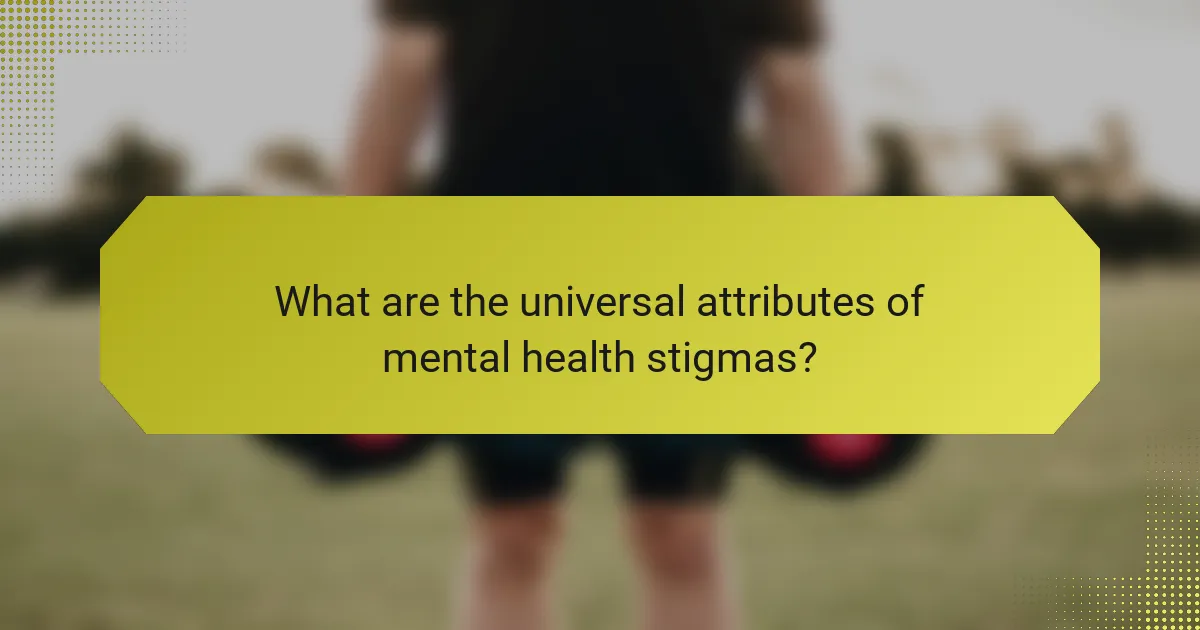Understanding mental health misconceptions is vital for fostering compassion and support. Common stigmas lead to discrimination and isolation, particularly for marginalized groups. Addressing these misconceptions requires education, open conversations, and tailored interventions to improve access to resources. Promoting empathy and awareness can dismantle harmful beliefs and create a more supportive environment for individuals facing mental health challenges.

What are the common misconceptions about mental health?
Many misconceptions about mental health perpetuate stigma and misunderstanding. Common beliefs include the idea that mental health issues are a sign of personal weakness, that individuals can simply “snap out of it,” and that mental health conditions are rare. These misconceptions hinder compassionate support and prevent individuals from seeking help. Understanding the unique attributes of mental health, such as its complex nature and the influence of biological, environmental, and psychological factors, is crucial for fostering a more informed and supportive society. Promoting awareness and empathy can challenge these harmful stigmas and encourage open conversations.
How do these misconceptions affect individuals seeking help?
Misconceptions about mental health can severely hinder individuals from seeking help. Stigmas create feelings of shame and isolation, discouraging open conversations about mental health issues. Many fear judgment or discrimination, leading to a reluctance to access necessary support services. This reluctance can exacerbate mental health conditions, prolong suffering, and diminish overall well-being. Compassionate support is essential to counteract these harmful effects and encourage individuals to pursue treatment.
What role does media play in perpetuating mental health stigmas?
Media plays a significant role in perpetuating mental health stigmas by reinforcing misconceptions and negative stereotypes. Through sensationalized portrayals, media often depicts individuals with mental health conditions as dangerous or unstable, which contributes to public fear and misunderstanding. Research indicates that negative media representations can lead to increased stigma and discrimination, making it harder for individuals to seek help. Additionally, the lack of accurate information in media narratives limits public awareness of mental health issues, further entrenching harmful beliefs. Promoting compassionate and accurate representations can help combat these stigmas and foster a supportive environment for those affected.
Which media representations contribute to negative perceptions?
Media representations that depict individuals with mental health issues as dangerous or unpredictable contribute significantly to negative perceptions. Such portrayals often stem from sensationalized news coverage and fictional narratives. Research shows that these stigmas can lead to social isolation and reluctance to seek help. For instance, a study found that 60% of people with mental health conditions reported feeling judged due to media portrayals. Additionally, negative stereotypes in films and television reinforce misconceptions, impacting public attitudes and policy. Compassionate support can counter these harmful narratives.
How can positive media portrayals change the narrative?
Positive media portrayals can significantly shift the narrative surrounding mental health by fostering empathy and understanding. These representations challenge existing misconceptions and reduce stigma, promoting compassionate support. When media accurately depicts mental health struggles, it encourages conversations and awareness, leading to better societal attitudes. Research shows that positive portrayals can influence public perceptions, ultimately driving policy changes and enhancing access to mental health resources.

What are the universal attributes of mental health stigmas?
Mental health stigmas universally manifest as misconceptions that lead to discrimination and isolation. These stigmas are often rooted in fear, misunderstanding, and cultural beliefs. Common attributes include negative stereotypes, social exclusion, and a lack of awareness about mental health conditions. As a result, individuals facing mental health challenges may experience reduced access to support and treatment. Addressing these stigmas requires promoting education, empathy, and compassionate support systems.
How do cultural beliefs influence mental health perceptions?
Cultural beliefs significantly shape mental health perceptions, often leading to morally reprehensible stigmas. These stigmas can perpetuate misconceptions, resulting in discrimination and isolation for individuals facing mental health challenges. For instance, some cultures may view mental illness as a personal weakness, fostering shame instead of support. As a result, individuals may avoid seeking help, exacerbating their conditions. Promoting compassionate support requires understanding these cultural contexts and challenging harmful beliefs. Efforts to educate communities can transform perceptions, encouraging empathy and acceptance.
What are the psychological impacts of stigma on individuals?
Stigma negatively impacts individuals by fostering feelings of shame, isolation, and low self-esteem. These psychological effects can lead to anxiety, depression, and reluctance to seek help. Stigmatized individuals often internalize negative perceptions, which can exacerbate mental health conditions. As a result, promoting compassionate support is crucial for mitigating these effects and encouraging recovery.

What unique challenges do marginalized groups face regarding mental health?
Marginalized groups face significant mental health challenges due to systemic stigmas and misconceptions. These groups often encounter barriers such as limited access to mental health resources, cultural misunderstandings, and social isolation.
Stigmas surrounding mental health can exacerbate feelings of shame and reluctance to seek help. For instance, individuals from these communities may fear discrimination or invalidation by healthcare providers, leading to underutilization of available services.
Moreover, unique attributes like socioeconomic status and cultural beliefs can influence how mental health issues are perceived and addressed. As a result, tailored interventions that promote understanding and compassion are essential for improving outcomes in these populations.
Addressing these challenges requires a concerted effort to dismantle harmful stigmas and create supportive environments that encourage open dialogue about mental health.
How does intersectionality affect mental health stigma?
Intersectionality significantly amplifies mental health stigma by intertwining various social identities. Individuals facing multiple marginalized identities often experience compounded discrimination, leading to greater isolation and misunderstanding. For example, a person who identifies as both a racial minority and has a mental health condition may encounter unique challenges that exacerbate stigma. This complexity hinders access to compassionate support, as societal misconceptions about mental health can vary widely across different cultural contexts. Ultimately, addressing intersectionality is crucial for creating effective mental health advocacy and support systems.
What specific resources are available for these groups?
Various resources are available to support individuals facing mental health misconceptions. These include educational programs, support groups, online platforms, and mental health professionals. Educational programs provide information to combat stigma and promote understanding. Support groups offer a safe space for shared experiences and emotional support. Online platforms, such as forums and social media, facilitate community building and resource sharing. Mental health professionals provide expert guidance and treatment options tailored to individual needs.

What rare but notable instances of stigma have emerged recently?
Recent notable instances of stigma surrounding mental health include public backlash against mental health discussions and increased social media scrutiny. These stigmas often arise from misconceptions about mental illness, leading to isolation for those affected. For example, individuals sharing their experiences may face ridicule or dismissal. This highlights the need for compassionate support and education to combat stigma effectively.
How have social media movements impacted mental health awareness?
Social media movements have significantly increased mental health awareness by challenging stigmas and promoting understanding. These platforms allow individuals to share personal experiences, fostering a sense of community and support. As a result, misconceptions about mental health are being addressed, leading to more compassionate responses. For example, campaigns like #MentalHealthAwarenessMonth have encouraged open discussions, reducing feelings of isolation among those struggling. Such initiatives empower individuals to seek help and advocate for systemic changes in mental health care.
What lessons can be learned from recent mental health advocacy campaigns?
Recent mental health advocacy campaigns highlight the importance of compassion in combating stigmas. These initiatives reveal that education reduces misconceptions and fosters supportive environments. Campaigns often utilize personal stories, illustrating the human experience behind mental health challenges. As a result, they promote empathy and understanding, encouraging communities to offer tangible support.

What are the best practices for promoting compassionate support?
Promoting compassionate support involves creating an inclusive environment and addressing mental health misconceptions. First, educate the community about mental health issues to dismantle stigmas. Second, encourage open conversations to foster understanding and empathy. Third, provide training for individuals in supportive roles to enhance their skills in offering compassionate assistance. Lastly, share personal stories to humanize mental health experiences, making them relatable and reducing isolation.
How can individuals contribute to reducing stigma in their communities?
Individuals can reduce stigma by promoting understanding and compassion towards mental health issues. They can engage in open conversations, challenge stereotypes, and educate themselves and others about mental health. Sharing personal experiences can foster empathy and connection. Supporting mental health initiatives and participating in community events can further raise awareness and encourage acceptance. Active listening and validating the feelings of those affected by mental health challenges contribute to a more supportive environment.
What strategies can organizations implement to foster inclusive environments?
Organizations can implement several strategies to foster inclusive environments. First, provide mental health training to all employees, promoting understanding and compassion. Second, establish support groups that encourage open dialogue about mental health. Third, create policies that prioritize mental well-being, ensuring access to resources. Fourth, celebrate diversity through events that highlight various mental health experiences. These strategies can significantly reduce stigma and promote a culture of support.
How can training and education improve understanding of mental health?
Training and education significantly enhance understanding of mental health by dispelling misconceptions and fostering empathy. Comprehensive programs equip individuals with knowledge about mental health conditions, reducing stigma. For example, awareness initiatives can clarify that mental health issues are medical conditions, not personal failings. As a result, compassionate support becomes more prevalent, encouraging open dialogue and acceptance. Educational interventions have been shown to improve attitudes towards mental health, leading to greater community support and reduced discrimination.
What common mistakes should be avoided when discussing mental health?
Avoiding common mistakes in mental health discussions is crucial for promoting understanding and compassion. Key errors include using stigmatizing language, oversimplifying conditions, and neglecting individual experiences. Failing to acknowledge the complexity of mental health can perpetuate misconceptions. Additionally, offering unsolicited advice instead of support can alienate those in need. Engaging in active listening and validating feelings fosters a more supportive environment.
What actionable steps can be taken to support those affected by stigma?
To support those affected by stigma, promote understanding and compassion through education, active listening, and community involvement. Educate yourself and others about mental health to dispel misconceptions. Encourage open conversations to foster empathy and support. Engage in community initiatives that promote mental health awareness and provide safe spaces for dialogue. Advocate for policy changes that protect the rights of individuals facing stigma, ensuring their voices are heard and valued.


